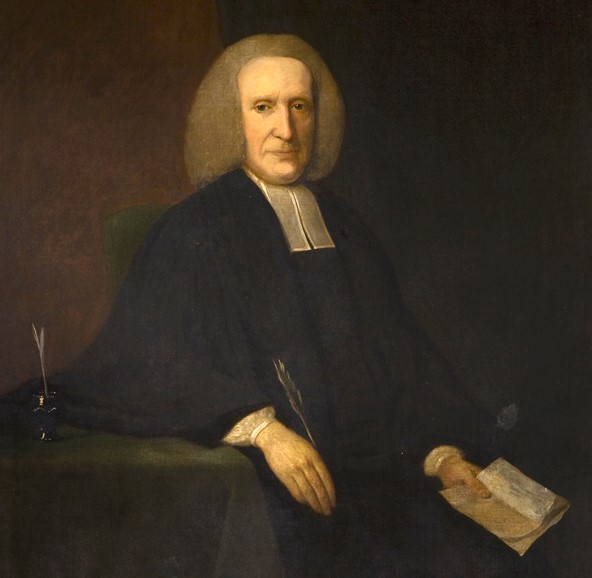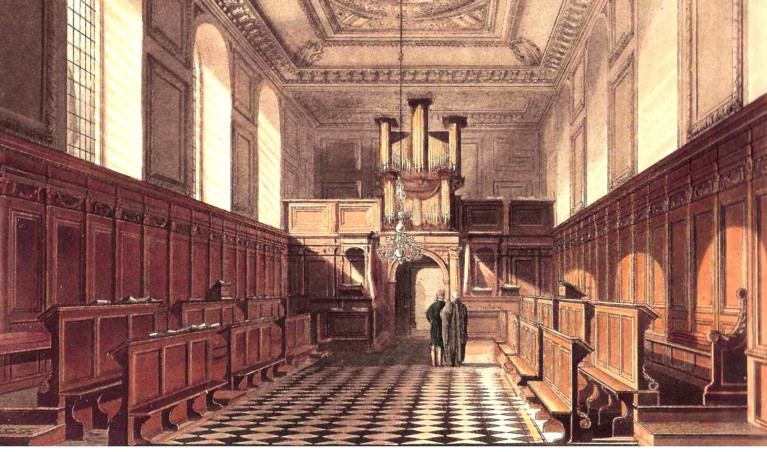Blog
6 September 2023

Dr William Richardson
Almost every biographical source for Dr William Richardson, Master of Emmanuel 1735-1775, states that he is buried in the college chapel. There are good reasons to question this assertion.
Recent sources are doubtless quoting the relevant entry in Venn’s Alumni Cantabrigienses, published in the 1920s. The authors of this listing of Cambridge University men appear to have taken the information about Richardson from the Dictionary of National Biography, compiled in the late nineteenth century. The DNB had, in turn, relied on Nichols’s Literary Anecdotes. The earliest edition of this work, published in 1782, stated: ‘[Richardson] died March 14, 1775, and was buried in the same vault with his wife, under the litany desk in the chapel of his College’. The principal authors of Literary Anecdotes were William Bowyer (died 1777) and his assistant, and later successor, John Nichols. Bowyer had been up at Cambridge at the same time as Richardson and may have known him then, or perhaps later, when they were members of the Royal Society of Antiquaries.
Given that the passage about Richardson was written relatively soon after his death, it ought, in theory, to be trustworthy. Yet the fact remains that nothing has been found in the college archives to corroborate the burial of either Richardson or his wife in Emmanuel’s chapel (no payments to gravediggers, for instance). Their deaths are recorded in the church registers of the parish of St Andrew the Great, which state that ‘Mrs Ann Richardson’ was buried on 27 March 1759, and ‘Dr Richardson Mr of Eml Coll’ on 19 March 1775. In neither case is there any suggestion that the interment was at Emmanuel, rather than at St Andrew’s. This may well be a significant omission, as the parish records usually (but admittedly not invariably) note such things.
Another source of doubt is the absence of any memorial to Dr Richardson in the chapel. It is difficult to believe that the college did not mark his grave by (at the very least) incising his initials into a floor tile, as it was to do for several other masters. It seems equally unlikely that Richardson had, for sixteen years, similarly failed to indicate his wife’s burial spot. If there ever was an engraved tile it soon disappeared, for the Richardsons are not mentioned in Cooper’s Memorials of Cambridge (published 1861), which recorded all the monumental inscriptions at Emmanuel. During the chapel restoration works of 2003-4, a brick-lined burial vault was discovered abutting the east wall. This appeared to contain only one (collapsed) coffin, so cannot be the Richardsons’ grave. It is almost certainly the tomb of John Breton, Master 1665-1676, whose corpse was transferred in 1677 from the old chapel to the new, as recorded in the college archives.

Emmanuel Chapel, 1814. Do the Richardsons lie beneath the marble tiles?
If Ann Richardson was indeed buried in Emmanuel’s chapel, it would have been the first instance of a non-collegiate person (and a woman, to boot) being afforded such an honour, and therefore seems inherently unlikely. The moveable litany desk, beneath which the Richardsons are said to lie, would have been placed in the nave, probably about halfway down. During the 2003-4 works all the marble floor tiles in that area were lifted, without revealing any evidence of a grave. The only way to test conclusively the claim made in Literary Anecdotes would be to excavate the entire floor of the chapel, which is clearly out of the question, at least for such a purpose. As things stand, all that can be said is that while the Richardsons may be buried in Emmanuel’s chapel, the weight of circumstantial evidence is against it.
Amanda Goode, College Archivist
